2014 MITSUBISHI LANCER SPORTBACK child seat
[x] Cancel search: child seatPage 8 of 422

Interior
Overview 1-6
1
Supplemental restraint system
- curtain airbag P.4-34
Coat hook P.5-192
Dome light (Rear) (if so equipped) P.5-185, 9-35, 9-47
Assist grips P.5-192
Luggage compartment levers P. 4 - 9
Tether anchors for child restraint system P.4-18
Rear seats P.4-5
Cargo floor boxes (if so equipped) P.5-189
Cup holder (for rear seat) P.5-190
Dual height adjustable cargo floor board (if so equipped) P.5-191
Arm rest P.4-5
BK0200700US.bo
ok 6 ページ 2013年2月15日 金曜日 午後12時17分
Page 28 of 422
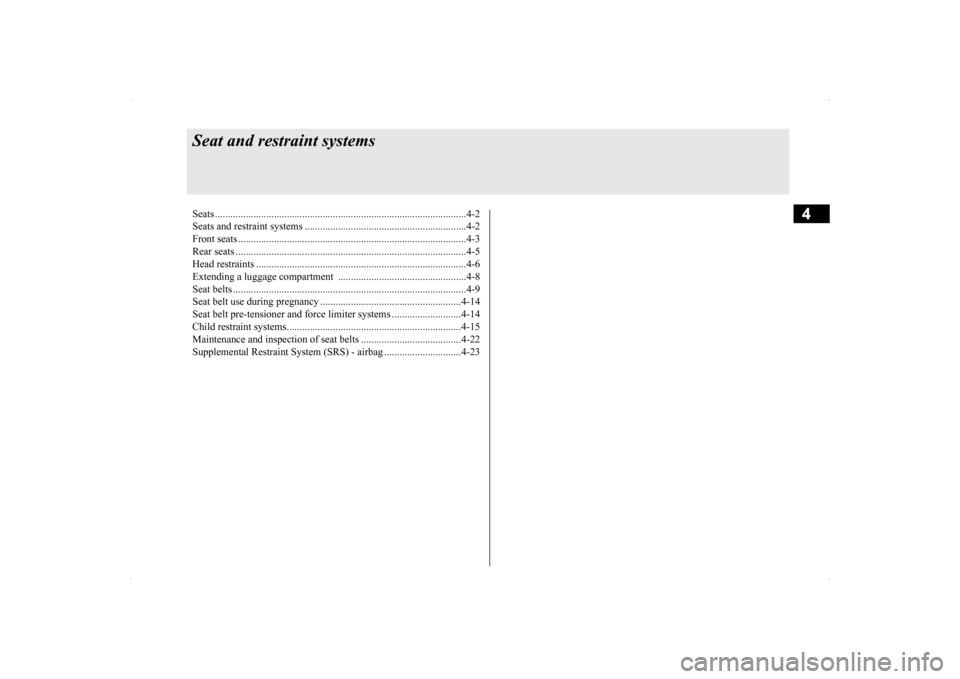
4
Seat and restraint systemsSeats ...........................................
.......................................................4-2
Seats and restraint syst
ems ...............................................................4-2
Front seats ........................
.................................................................4-3
Rear seats .........................
.................................................................4-5
Head restraints .................
.................................................................4-6
Extending a luggage comp
artment ..................................................4-8
Seat belts ..........................
.................................................................4-9
Seat belt use during preg
nancy .......................................................4-14
Seat belt pre-tensioner and fo
rce limiter systems ...........................4-14
Child restraint system
s............................................
........................4-15
Maintenance and inspection of seat belts .......................................4-22 Supplemental Restraint System (SRS) - airbag ..............................4-23
BK0200700US.bo
ok 1 ページ 2013年2月15日 金曜日 午後12時17分
Page 29 of 422
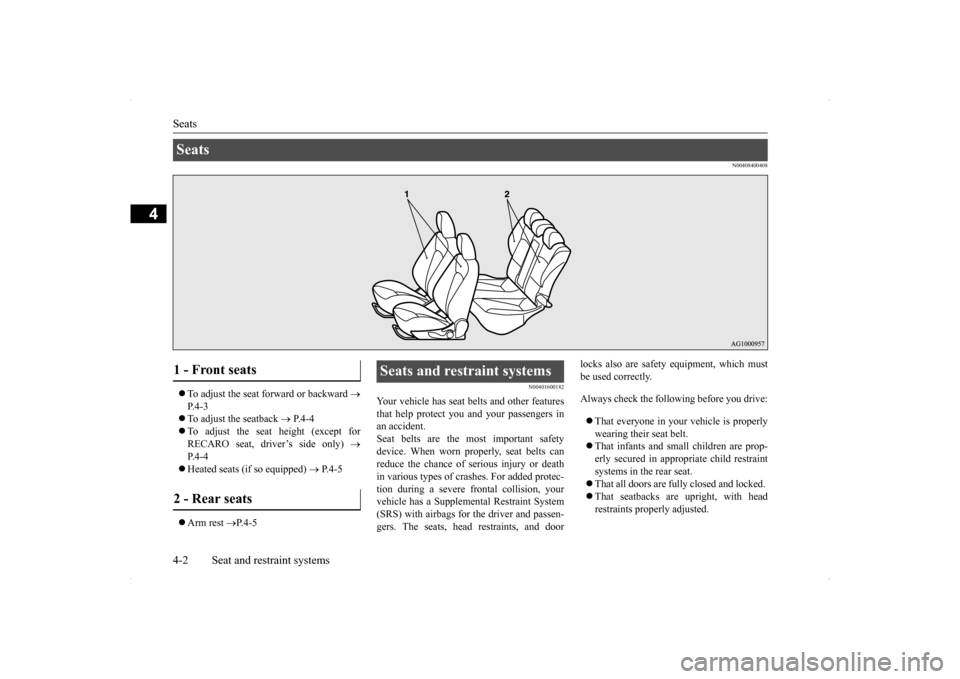
Seats 4-2 Seat and restraint systems
4
N00408400408
To adjust the seat forward or backward
P.4-3 To adjust the seatback
P.4-4
To adjust the seat height (except for RECARO seat, driver’s side only)
P.4-4 Heated seats (if so equipped)
P.4-5
Arm rest
P.4-5
N00401600182
Your vehicle has seat belts and other features that help protect you and your passengers in an accident. Seat belts are the most important safetydevice. When worn properly, seat belts can reduce the chance of serious injury or death in various types of crashes. For added protec-tion during a severe frontal collision, your vehicle has a Supplemental Restraint System (SRS) with airbags for the driver and passen-gers. The seats, head restraints, and door
locks also are safety equipment, which must be used correctly. Always check the following before you drive: That everyone in your vehicle is properly wearing their seat belt. That infants and small children are prop- erly secured in appropriate child restraint systems in the rear seat. That all doors are full
y closed and locked.
That seatbacks are upright, with head restraints properly adjusted.
Seats 1 - Front seats 2 - Rear seats
Seats and restraint systems
BK0200700US.bo
ok 2 ページ 2013年2月15日 金曜日 午後12時17分
Page 30 of 422
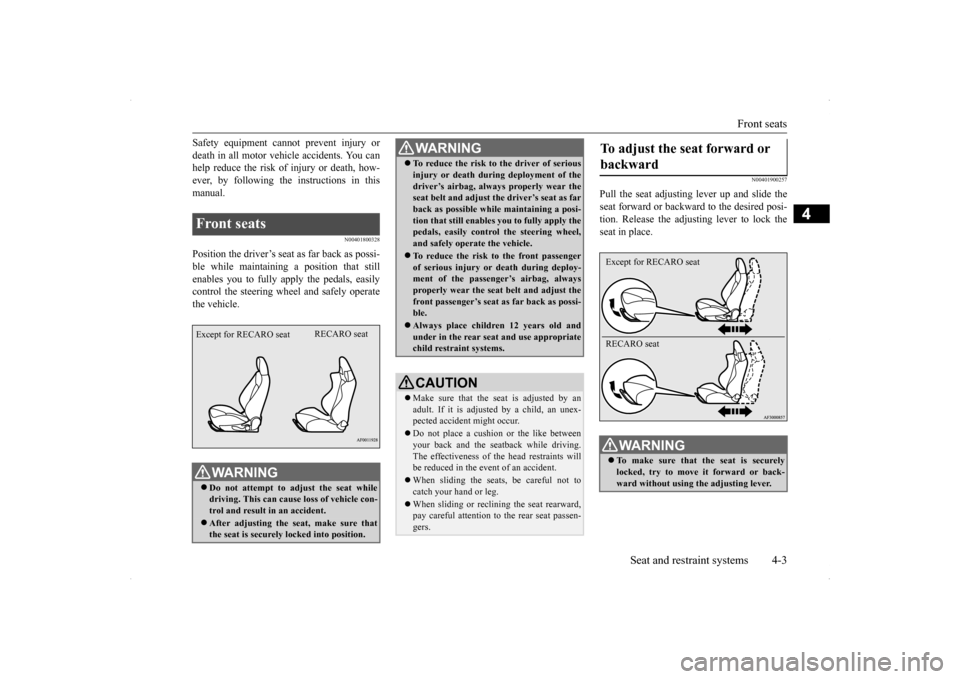
Front seats
Seat and restraint systems 4-3
4
Safety equipment cannot prevent injury or death in all motor vehicle accidents. You can help reduce the risk of injury or death, how- ever, by following the
instructions in this
manual.
N00401800328
Position the driver’s seat
as far back as possi-
ble while maintaining a position that stillenables you to fully apply the pedals, easily control the steering wheel and safely operate the vehicle.
N00401900257
Pull the seat adjusting lever up and slide theseat forward or backward to the desired posi- tion. Release the adjusting lever to lock the seat in place.
Front seats
WA R N I N G Do not attempt to adjust the seat while driving. This can cause loss of vehicle con-trol and result in an accident. After adjusting the seat, make sure that the seat is securely locked into position.
Except for RECARO seat
RECARO seat
To reduce the risk to the driver of serious injury or death during deployment of the driver’s airbag, always properly wear the seat belt and adjust th
e driver’s seat as far
back as possible while maintaining a posi-tion that still enables
you to fully apply the
pedals, easily control the steering wheel, and safely operate the vehicle. To reduce the risk to the front passenger of serious injury or death during deploy-ment of the passenger’s airbag, always properly wear the seat belt and adjust the front passenger’s seat as far back as possi-ble. Always place children 12 years old and under in the rear seat and use appropriate child restraint systems.CAUTION Make sure that the seat is adjusted by an adult. If it is adjusted by a child, an unex-pected accident might occur. Do not place a cushion or the like between your back and the seatback while driving. The effectiveness of the head restraints will be reduced in the event of an accident. When sliding the seats, be careful not to catch your hand or leg. When sliding or reclining the seat rearward, pay careful attention to the rear seat passen- gers.WA R N I N G
To adjust the seat forward or backward
WA R N I N G To make sure that the seat is securely locked, try to move it forward or back- ward without using the adjusting lever. Except for RECARO seat RECARO seat
BK0200700US.bo
ok 3 ページ 2013年2月15日 金曜日 午後12時17分
Page 35 of 422

Extending a luggage compartment 4-8 Seat and restraint systems
4
N00405500088
WA R N I N G In order to minimize the risk of a neck injury due to a rear impact, the driver and front passenger seatbacks must beadjusted to the upright position before vehicle operation. The driver should never adjust the seat while the vehicle is inmotion. Never place a cushion or similar device on the seatback. This can adversely affect head restraint performance by increasing the distance between your head and therestraint.
Extending a luggage com- partment
WA R N I N G Never adjust the seats to extend a luggage compartment while the vehicle is in motion or on a slope. The seats could move suddenly and causeserious injury or an accident. After returning a seatback to its normal position, make sure that the seatback is firmly secured. If the seatback is not secured, it could move and cause a seriousaccident. Do not allow anyone to ride in the luggage compartment while the vehicle is in motion. People who are not properly seated and restrained can be seriouslyinjured or killed in an accident. The luggage compartment in the rear of the vehicle should never be used as a play area by children. All children should be properly restrained in a restraint devicethat offers the maximum protection for their size and age. Refer to “Child restraint systems” on page 4-15.
The front passenger seat is equipped with weight sensors. Depending on the weight detected, the front passenger airbag is dis- abled or enabled. When folding the rear seats forward for increased cargo capac-ity, the front passenger seat and seatback must be adjusted to assure they are not contacting the rear seat. In the event thefront seat or seatback is allowed to contact the folded rear seat, proper operation of the front passenger airbag system may beaffected.CAUTION In the luggage compartme
nt, do not load the
luggage higher than the top of the seats and make sure that the luggage is firmly secured.Restricted rear vision or unsecured objects entering the passenger compartment from the luggage compartment during sudden brak-ing can cause serious injury or an accident. Seatbacks should always be folded and put back into normal position by an adult. Seat adjustments by a child could lead to an unex- pected accident. When adjusting the seats, be careful not to catch your hand or leg. Personal injury could result.WA R N I N G
BK0200700US.bo
ok 8 ページ 2013年2月15日 金曜日 午後12時17分
Page 37 of 422
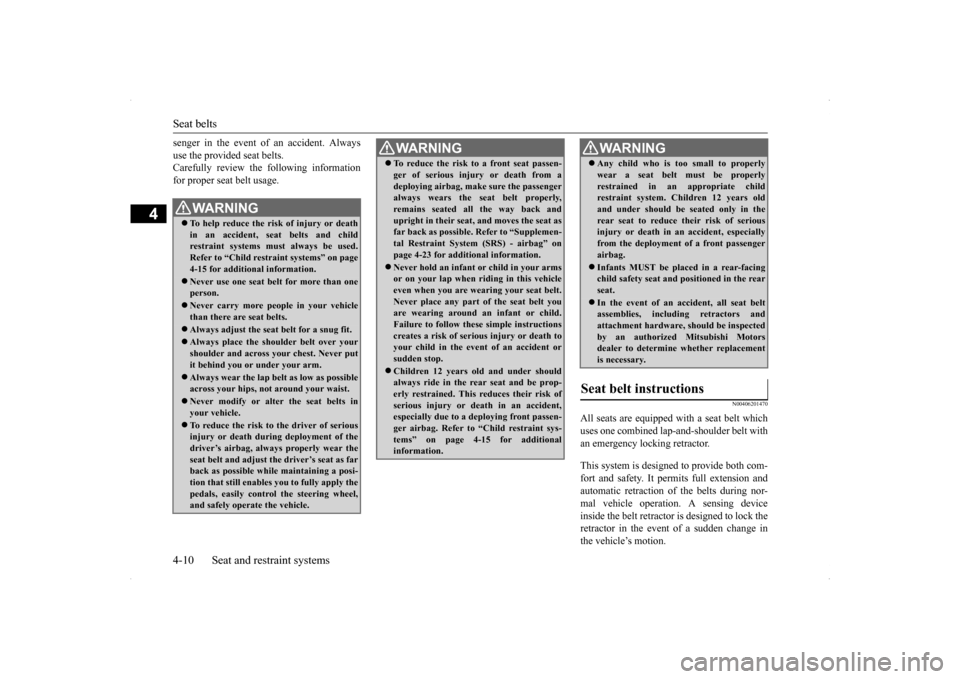
Seat belts 4-10 Seat and restraint systems
4
senger in the event of an accident. Always use the provided seat belts. Carefully review the following information for proper seat belt usage.
N00406201470
All seats are equipped with a seat belt whichuses one combined lap-and-shoulder belt withan emergency locking retractor. This system is designed to provide both com- fort and safety. It permits full extension and automatic retraction of the belts during nor-mal vehicle operation. A sensing device inside the belt retractor is designed to lock the retractor in the event of a sudden change inthe vehicle’s motion.
WA R N I N G To help reduce the risk of injury or death in an accident, seat belts and childrestraint systems must always be used. Refer to “Child restraint systems” on page 4-15 for additional information. Never use one seat belt for more than one person. Never carry more people in your vehicle than there are seat belts. Always adjust the seat
belt for a snug fit.
Always place the shoulder belt over your shoulder and across your chest. Never put it behind you or under your arm. Always wear the lap belt as low as possible across your hips, not around your waist. Never modify or alter the seat belts in your vehicle. To reduce the risk to the driver of serious injury or death during deployment of thedriver’s airbag, always properly wear the seat belt and adjust the driver’s seat as far back as possible while maintaining a posi- tion that still enables you to fully apply the pedals, easily control the steering wheel,and safely operate the vehicle.
To reduce the risk to a front seat passen- ger of serious injury or death from a deploying airbag, make sure the passenger always wears the seat belt properly, remains seated all the way back andupright in their seat, and moves the seat as far back as possible. Refer to “Supplemen- tal Restraint System (SRS) - airbag” onpage 4-23 for additional information. Never hold an infant or child in your arms or on your lap when riding in this vehicle even when you are wearing your seat belt. Never place any part of the seat belt youare wearing around an infant or child. Failure to follow these simple instructions creates a risk of serious injury or death toyour child in the event of an accident or sudden stop. Children 12 years old and under should always ride in the rear seat and be prop- erly restrained. This reduces their risk ofserious injury or death in an accident, especially due to a deploying front passen- ger airbag. Refer to “Child restraint sys-tems” on page 4-15 for additional information.WA R N I N G
Any child who is too small to properly wear a seat belt must be properly restrained in an appropriate child restraint system. Children 12 years old and under should be se
ated only in the
rear seat to reduce their risk of serious injury or death in an accident, especially from the deployment of a front passengerairbag. Infants MUST be placed in a rear-facing child safety seat and positioned in the rear seat. In the event of an accident, all seat belt assemblies, including retractors and attachment hardware, should be inspectedby an authorized Mitsubishi Motors dealer to determine whether replacement is necessary.
Seat belt instructions
WA R N I N G
BK0200700US.bo
ok 10 ページ 2013年2月15日 金曜日 午後12時17分
Page 38 of 422

Seat belts
Seat and restraint systems 4-11
4
1. Occupants should always sit back in their seats with their backs against the upright seatback. To reduce the risk of seriousinjury or death during deployment of theairbag, adjust the driver’s seat as far back as possible while maintaining a position that still enables you to fully apply thepedals, easily control the steering wheel, and safely operate the vehicle. The front passenger seat should also be moved asfar back as possible. Refer to “Supple- mental Restraint System (SRS) - airbag” on page 4-23. Also refer to “To adjust theseat forward or backward” on page 4-3.
2. Grasp the latch plate and slide it up the webbing so that it easily pulls across yourbody.
3. Pull the seat belt out slowly while holding the latch plate. Push the latch plate into the buckle until you hear a “click”. Pull up on the belt to be sure the latch plate islocked securely in the buckle.
NOTE
For instructions on installing a child restraint system using a seat belt, refer to “Installing a child restraint system using the seat belt” on page 4-20.
WA R N I N G To reduce the risk of serious injury or death in the event of an accident or sud- den stop, all seatbacks should be kept in the upright position while the vehicle is in motion.Seat belt performance during an accident can be adversely affected if the seatbacks are reclined. The more a seatback isreclined, the more likely seat belt perfor- mance will be adversely affected. If the seat belt is not properly positioned againstthe body during an accident, there is increased risk you will slide under the belt and receive serious injury or death.
NOTE
If the seat belt locks up and cannot be pulled out, pull it once with force and let it retractall the way. Then, pull the belt out slowly once again.
BK0200700US.bo
ok 11 ページ 2013年2月15日 金曜日 午後12時17分
Page 39 of 422
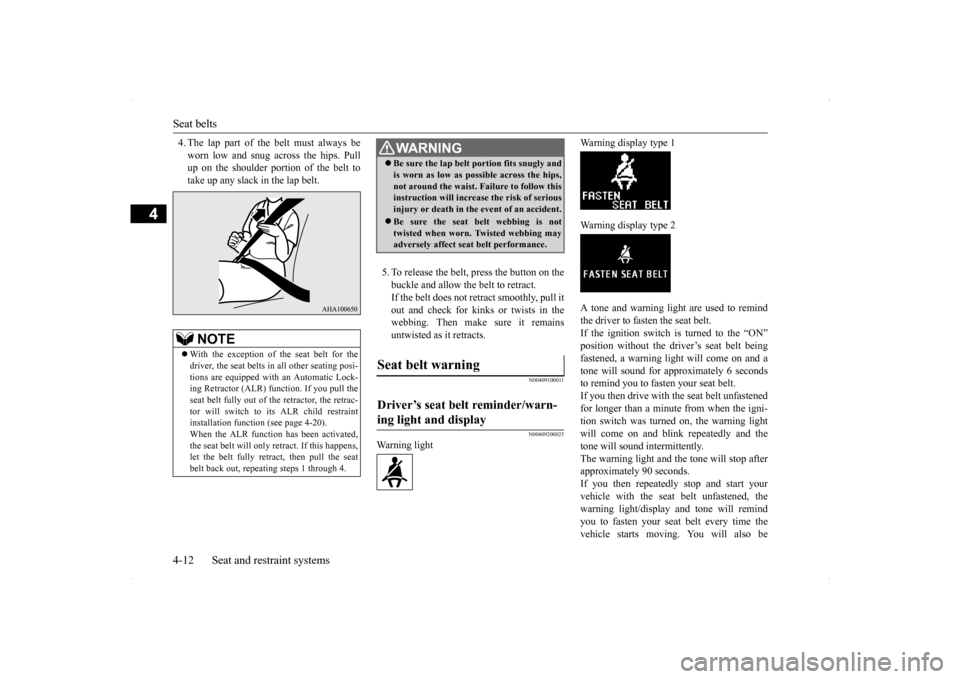
Seat belts 4-12 Seat and restraint systems
4
4. The lap part of the belt must always be worn low and snug across the hips. Pull up on the shoulder portion of the belt to take up any slack in the lap belt.
5. To release the belt, press the button on the buckle and allow the belt to retract. If the belt does not retract smoothly, pull itout and check for kinks or twists in the webbing. Then make sure it remains untwisted as it retracts.
N00409100011 N00409200025
Warning light
Warning display type 1 Warning display type 2 A tone and warning light are used to remind the driver to fasten the seat belt.If the ignition switch is turned to the “ON” position without the driver’s seat belt being fastened, a warning light will come on and atone will sound for approximately 6 seconds to remind you to fasten your seat belt. If you then drive with the seat belt unfastenedfor longer than a minute from when the igni- tion switch was turned on, the warning light will come on and blink repeatedly and thetone will sound intermittently.The warning light and the tone will stop after approximately 90 seconds. If you then repeatedly stop and start yourvehicle with the seat belt unfastened, the warning light/display and tone will remind you to fasten your seat belt every time thevehicle starts moving. You will also be
NOTE
With the exception of the seat belt for the driver, the seat belts in all other seating posi- tions are equipped with an Automatic Lock- ing Retractor (ALR) function. If you pull theseat belt fully out of the retractor, the retrac- tor will switch to its ALR child restraint installation function (see page 4-20).When the ALR function has been activated, the seat belt will only retract. If this happens, let the belt fully retract, then pull the seatbelt back out, repeating steps 1 through 4.
WA R N I N G Be sure the lap belt portion fits snugly and is worn as low as possible across the hips, not around the waist. Failure to follow this instruction will increase the risk of serious injury or death in the
event of an accident.
Be sure the seat belt webbing is not twisted when worn. Twisted webbing mayadversely affect seat belt performance.
Seat belt warning Driver’s seat belt reminder/warn- ing light and display
BK0200700US.bo
ok 12 ページ 2013年2月15日 金曜日 午後12時17分